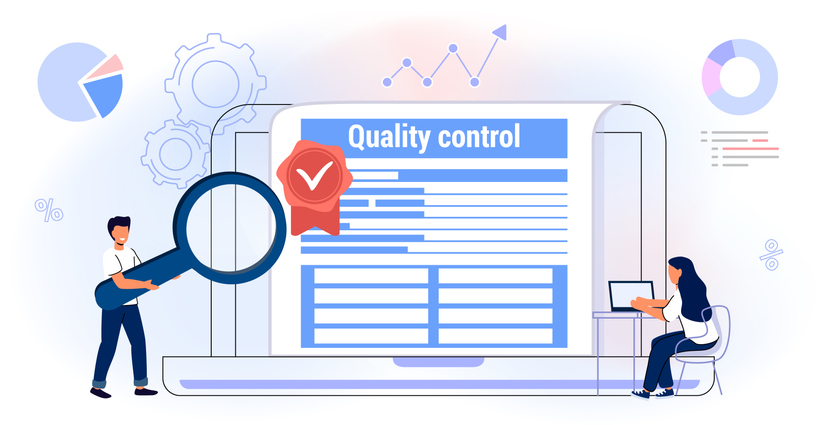As we provide QMS Consulting Services across multiple industries, we know the importance of digitizing your quality control. Here’s a guide to choosing the right manufacturing quality control software for your organization.
An Overview of Manufacturing Quality Control Software
In today’s competitive manufacturing industry, quality control has become a critical aspect of any successful operation.
Companies must ensure that their products meet the highest standards before reaching consumers.
However, the traditional methods of quality control can be time-consuming, inefficient, and prone to human error. That’s where quality management software comes in.
Manufacturing quality control software (or quality management software) is a technology solution that enables companies to automate their quality control processes, ensuring consistency and efficiency.
It helps manufacturers maintain consistent quality assurance, from managing their production lines to tracking quality metrics to identifying defects or issues in real-time.
By automating the quality control process, companies can reduce the risk of errors, minimize waste, and ensure the overall quality of their products.
Why Companies Need Manufacturing Quality Control Software

First and foremost, it ensures that the products meet the required standards consistently.
This, in turn, helps manufacturers maintain customer satisfaction, improve their brand image, and build customer loyalty.
Additionally, quality management software enables companies to streamline their production processes, reducing waste and improving efficiency.

In the manufacturing industry, quality is critical to a company’s success.
Customers expect top-quality products and services that meet the most stringent quality standards.
To deliver world-class quality, manufacturing companies control their quality processes through a comprehensive quality management system (QMS).
How Manufacturing Quality Control Software Saves You Money
Quality Management Software is a powerful tool that helps businesses save money by streamlining operations and enhancing product quality. By effectively addressing key aspects, such as those discussed in the following section, QMS enables organizations to achieve cost savings while maintaining high standards and customer satisfaction.
Reduce Scrap and Rework Costs
- Automate data collection and analysis from various stages of the production process, helping to identify quality issues early and notify operators to take corrective actions.
- Identify the root cause of quality issues by analyzing historical data and identifying trends and patterns that lead to defects.
- Streamline communication between different teams involved in the quality control process, ensuring that everyone is on the same page and that quality issues are addressed in a timely and efficient manner.
- Reduce human error by automating data entry and calculations, reducing the risk of mistakes that can lead to quality issues.
- Identify bottlenecks or inefficiencies that may be leading to quality issues and improve the consistency and efficiency of the quality control process.
Reduce Warranty and Liability Costs
- Reduce the number of warranty claims and legal liability costs by ensuring that products meet quality requirements before they leave the factory.
- Maintain regulatory compliance by providing a standardized process for ensuring that products meet necessary regulatory requirements.
- Automatically check for compliance at every step of the manufacturing process, from raw materials to finished products.
- Maintain a complete audit trail of all quality-related activities, including inspections, tests, and corrective actions, which can be used to demonstrate compliance during regulatory audits.
- Get automated alerts and notifications to ensure that quality-related tasks are completed on time, reducing the risk of non-compliance.
- Gain real-time visibility to quickly identify and address any quality issues that arise, further reducing the risk of non-compliance.
Increase Efficiency
- Standardize and streamline the quality control process, reducing errors and speeding up inspections.
- Automate data collection and analysis, providing real-time insights to optimize processes.
- Automate the generation of reports, alerts, and notifications, reducing the time and resources needed to manage quality control processes.
Improve Supplier Performance
- Track and manage supplier performance by providing a centralized supplier quality management system to monitor supplier quality metrics, automate the evaluation process, and identify potential quality issues.
- Track supplier performance over time and make informed decisions about future partnerships, ensuring consistent standards of quality and reducing the risk of quality-related issues
- Facilitate communication with your suppliers, improving collaboration, addressing issues quickly, and fostering a stronger, more productive relationship.
- Reduce the risk of quality-related issues, improve the efficiency of supply chain management systems, and save money.
Improve Overall Equipment Effectiveness (OEE)
- Improve OEE by reducing downtime associated with quality issues.
- Catch quality issues early and take corrective actions, minimizing unscheduled maintenance or repairs and reducing maintenance costs.
- Schedule proactive maintenance to prevent unexpected downtime.
- Optimize production schedules by identifying the most efficient order to produce products, increasing production capacity and further improving OEE.
Reduce the Cost of Regulatory Compliance
- Maintain a comprehensive audit trail of quality control processes, reducing the risk of non-compliance-related costs.
- Implement processes and procedures that comply with regulatory requirements, such as good manufacturing practices or standard operating procedures.
- Stay up-to-date with regulatory changes with software alerts about necessary changes to be made to comply with new regulations.
Choosing Manufacturing Quality Control Software
Choosing the right manufacturing quality control software can be a daunting task, but it doesn’t have to be. Here are some factors to consider when selecting a solution:
Document control
Quality management software typically includes document control features to manage the creation, approval, distribution, and archiving of documents related to quality management processes.
Here are some common ways that quality management software handles document control:
Centralized document repository: Quality management software provides a centralized repository for all quality-related documents, including policies, procedures, work instructions, forms, and templates. This allows users to easily access the latest versions of documents and ensures that everyone is working from the same set of documents.
Version control: Quality management software ensures that documents are always up-to-date by providing version control features. This allows users to track changes to documents over time and ensures that everyone is working with the latest version of a document.
Workflow management: Quality management software provides workflow management features to ensure that documents are created, reviewed, and approved by the appropriate personnel. This includes defining workflows for document review and approval, assigning tasks to specific users, and setting deadlines for completion.
Access control: Quality management software provides access control features to ensure that only authorized users can view and modify documents. This includes defining user roles and permissions, setting access levels for documents, and maintaining an audit trail of document access and changes.
Document distribution: Quality management software provides features to distribute documents to the appropriate personnel, including email notifications, alerts, and reminders. This ensures that everyone who needs to work with a particular document is aware of its existence and can access it easily.
Customization
The quality management software should be customizable to the unique needs of the manufacturing process. The software should allow users to tailor the quality control process, workflows, and reports to fit their specific requirements.
Creating custom workflows: Companies can create custom workflows that reflect their unique quality control processes. This can help to ensure that the software is aligned with their specific requirements and improve the efficiency of the quality control process.
Configuring data fields: The software should allow companies to configure data fields, which enable them to collect and store data relevant to their manufacturing processes. This customization can provide valuable insights into quality issues and help identify areas for improvement.
Customizing reports: The software should allow companies to generate custom reports that provide valuable insights into their quality control processes. This can include custom charts and graphs that enable companies to visualize data in a way that is most relevant to their needs.
Setting up alerts and notifications: Companies can set up custom alerts and notifications that notify relevant stakeholders about quality issues or changes to the quality control process. This can help to ensure that quality issues are addressed in a timely manner.
Integration
The software should be able to integrate with other software solutions, such as enterprise resource planning (ERP) software, to improve data flow and minimize errors.
- Companies can integrate their quality management software with other software solutions, such as ERP software, to improve data flow and minimize errors.
- Integration can be achieved through APIs or data connectors that allow data to flow between systems.
- The integration should be seamless, meaning that data should be automatically transferred from one system to another without manual data entry or file transfers.
Integration of quality control software with other software solutions can enable manufacturers to achieve a more holistic view of their operations, streamline their workflows, and reduce the risk of errors or data inconsistencies. - Integrating quality control software with ERP software can allow for real-time monitoring of inventory levels, production schedules, and quality data.
- This provides manufacturers with insights into their operations and enables them to make more informed decisions.
User-Friendliness
The software should be user-friendly and easy to use. This will reduce the learning curve and enable employees to adopt the software quickly.
- Intuitive Interface: The software should have an intuitive interface that is easy to navigate and use. This means that the software should have a clean and organized layout with clear labeling of functions and features.
- Simplified Processes: The software should simplify the quality control process, by breaking down complex tasks into simple, easy-to-understand steps. This can be achieved through the use of visual aids, such as flowcharts, checklists, or diagrams.
- Training and Support: The software vendor should provide comprehensive training management and support to help users get the most out of the software. This can include user manuals, video tutorials, and webinars.
- Customizable Views: The software should allow users to customize their views, such as dashboards or reports, to fit their specific needs. This can help users focus on the information that is most important to them, improving their productivity and efficiency.
- Mobile Accessibility: The software should have mobile accessibility, allowing users to access and use the software on-the-go using their mobile devices. This can help users stay connected and productive, even when they are away from their desktops.
Scalability
The software should be scalable to accommodate the needs of the manufacturing company as it grows.
- Quality management software can be scaled up or down to meet changing needs
- It can easily accommodate an increased number of users or new features
- Scalability can also refer to handling an increasing volume of data related to quality control
- Quality control software that is scalable can handle increased data volume without slowing down or crashing
- It should be able to integrate with new hardware and software as they are adopted by the company
- This ensures the software can grow and evolve with the company’s needs over time, from piecemeal to enterprise quality management software.
Support
The software vendor should provide reliable support, including training management, troubleshooting, and ongoing maintenance.
- Training – The software vendor can provide training sessions or materials to ensure that users are properly trained on how to use the software and its features.
- Troubleshooting – The software vendor can offer support to help users troubleshoot any issues or problems that arise while using the software.
- Maintenance – The software vendor can provide ongoing maintenance to ensure that the software is running smoothly and to fix any bugs or issues that are identified.
- Updates – The software vendor can release updates to the software to add new features or functionality, fix bugs, or address security vulnerabilities.
- Customer Service – The software vendor can offer customer service support to answer questions or address concerns that users may have about the software. This can include phone, email, or chat support.
Data Collection
Quality management software should capture a wide variety of data, depending on the specific requirements of the quality control process and also enabling statistical process control.
Here are a few examples of the types of data that may be captured:
- Product attributes: Capture data related to product attributes such as dimensions, weight, color, texture, and other physical characteristics.
- Defects: Capture data related to defects or non-conformances, including the type of defect, its location, and its severity.
- Process data: Capture data related to the manufacturing process itself, such as machine settings, cycle times, and other operational parameters.
- Environmental data: Capture data related to the manufacturing environment, such as temperature, humidity, and air quality.
- Test results: Capture data related to various tests that are performed on products, such as strength tests, durability tests, or chemical analyses.
- Supplier data: Capture data related to suppliers, such as their quality ratings, delivery times, and other relevant information.

Corrective actions can be tracked and managed in the software, reducing the cost of quality issues. Forms-based processes enable quality planning and control, ensuring that quality requirements are met consistently.
Manufacturing Quality Control Software Delivers World-Class Quality
Quality management software is a powerful tool for manufacturing companies to manage their quality processes effectively. It provides real-time data and analytics, supplier collaboration, and regulatory compliance.
By adopting such software, your company can establish a quality culture that delivers world-class quality to your customers.














